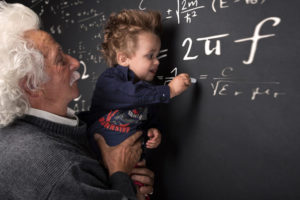by Emeritus Professor Miraca U.M. Gross
This article is being archived here, originally published in the Roeper Review, Vol. 11, No. 4, pp. 189-194, 1989
Educators often fail to recognize that the intellectually gifted differ from their age peers in their social and emotional development as much as in their intellectual and academic characteristics. A dilemma peculiar to gifted youth arises through the interaction of the psychosocial drives towards intimacy and achievement, which complement each other in students of average ability, but which place the gifted student in a forced-choice situation. If the gifted child chooses to satisfy the drive for excellence he or she must risk forfeiting the attainment of intimacy with age peers; if the choice is intimacy, the gifted may be forced into a pattern of systematic and deliberate underachievement to retain membership in the social group. Homogeneous grouping of gifted students is suggested as a partial solution to this dilemma.
“American education has found more comfort in assuming responsibility for socializing children than for meeting their unique educational needs.”
Joyce Van-Tassel Baska, Chicago, U.S.A., 1985
“Australian schools are evolving as multi-purpose social service agencies rather than pedagogical centres.”
K. Brian Start, Melbourne, Australia, 1985
It is ironic that at a time when American and Australian schools are increasingly abrogating their responsibilities towards the intellectual and academic development of their students to adopt, instead, the socializing roles formerly undertaken by the family and religion, the interest of many educators in intellectually gifted children is still stubbornly fixed on these students’ intellective characteristics, at the expense of any serious investigative concern for their social and emotional growth.
The problem is especially acute in Australia. Perhaps because of the dearth of Australian research into the needs and characteristics of the intellectually gifted child, and the unwillingness to interpret and harness overseas research, very little is known about the social and emotional needs of gifted children in Australia. Furthermore, investigation into the socio-emotional development of the highly able is hampered by the prevailing assumption that gifted students differ from their age peers on intellective factors alone.
So readily accepted is this assumption that it has become enshrined even in the policies of Australian State government education systems. The State Government of South Australia, in its 1983 Policy regarding fostering gifts and talents among children lists “the educational needs of all students which should also be acknowledged in programs intended to foster gifts and talents.” Throughout this list of “educational needs,” the emphasis is on the student not as an individual, but as a member of the educational community. The policy highlights, for example:
the need to be in an environment which … recognizes membership in a range of groups including family, cultural groups, (where in some cases group membership is more important than individual performance), age peers, friendship and interest groups, the wider school community and society at large; and to be aware that each group functions according to its own set of values (South Australian Education Department, 1983).
This interpretation of the student’s needs rests on two assumptions; first, that the values held by the gifted child will be congruent with the values of the social and cultural group from which he originates; and second, that where his cultural group values social cohesion above individual advancement (as in some Australian aboriginal cultures), the child will be able to balance the contrary dictates of his own intellectual drives and the expectations of his cultural peers. Both assumptions spring from a failure to realize that the intellectually gifted differ from their age peers in their emotional and social development as much as in their intellectual and academic characteristics.
Social and Emotional Differences
It is now generally understood and accepted that a child’s level of social and emotional development is more highly correlated with his mental age than with his chronological age (Tannenbaum, 1983; Janos and Robinson, 1985). Boehm’s (1962) and Kohlberg’s (1964) studies of moral development found that intellectually gifted children were able to make complex moral judgments much earlier than their age-peers of average ability, while some highly gifted elementary school children functioned at an externally controlled level of moral development normally found in less than ten percent of adults.
The gifted student’s enhanced capacity for abstract reasoning, coupled with his frequently accelerated capacity to obtain and process information, lead him to become familiar with, and speculate on, ideas not normally encountered until a much later age. Hollingworth (1926) noted that highly gifted children often become deeply concerned with questions of origin and destiny at an age when children of average ability are still absorbed in much more egocentric concerns. Serious difficulties of communication can arise when the child attempts to share his interests with age-peers, or even with adults who may be threatened by his unusual preoccupation with moral or religious complexities.
Malcolm
Malcolm, (IQ 165) is five years old. One evening at tea he engaged his parents in a serious and analytical discussion as to what would happen to the universe if God “stopped existing.” “After all,” Malcolm contended, “when anything dies it goes back into the earth. When stars go supernova everything they’re made of goes back into the universe. So if God died, what He is made of would go back into the universe too.” Malcolm wanted to know whether scientists could predict the changes that God’s death would cause to life on earth.
The child who can frame a sophisticated and coherent argument such as this clearly has needs and expectations far removed from those of the average five-year-old. He needs companions, preferably of his own age and ability level, with whom he can enjoy not only the pleasure and relaxation of play but also the stimulation of high level intellectual speculation. He needs warm and supportive home environment where his prodigious intellectual gifts are appreciated and where his urge to increase and develop his knowledge is understood and accepted a much as his childish desire for affection and approval. Especially he needs the support of adult friends and mentors who can appreciate that although high level of intellectual and moral development may permit him to speculate about matters such as the future of the universe, he is still a five-year-old child who may need comfort and reassuring when faced with the prospect of radical changes in his environment, even when it is his own philosophical musings which have prompted the vision change! Especially he needs to be reassured that, although “different” he is accepted both in his peer culture and in society at large.
Much of the emotional trauma experienced by intellectually gifted young people arises from the conflicting psycho-social needs of intimacy and achievement. In the child or adolescent of average ability, these needs are compatible, indeed complementary. For the highly gifted, however, achievement of his or her remarkable potential may lead at best to peer disapproval or, in severe cases, to social ostracism. American high school students actively reject those of their peers who demonstrate high level academic or intellectual prowess without the ameliorating effect of sporting or athletic interests (Tannenbaum, 1962).
If we review the research on these two psychosocial drives, particularly as they are manifested in intellectually gifted students, we can understand more clearly the peculiar social and emotional dilemma of the highly able.
The Need for Achievement and Excellence
School-age children quickly become aware of the importance of achievement. Even for young students, schools stress the importance of success in the acquisition of knowledge, and children learn to measure their achievement against that of their peers. For the intellectually gifted student, the shift away from a self-referenced understanding of ability towards a norm-referenced analysis of one’s ability as performance measured against the attainment standards of one’s peers, happens even earlier than for his age-mate of average ability. There is ample evidence that much of the socialization of achievement related motives takes place early in childhood (Steinberg).
Is the drive towards excellence innate in the intellectually gifted child or is it developmentally determined? Whether we believe, with Renzulli (Renzulli, 1978) that the motivation to excel is an integral component of giftedness, or, with Gagne (Gagne, 1985) that it acts, at a later stage, as a catalyst in the emergence of talent, we must ask ourselves when and how the drive itself develops.
Francis Galton believed that the motivation to achieve is inborn. He wrote of the “inherent stimulus” and “labour-loving instinct” which are among “those qualities of intellect and disposition which urge and qualify a man to perform acts which lead to reputation” (Galton, 1869). All these qualities were seen, by Galton, as “natural ability.”
Others maintain, however, that the motivation to excel is primarily the result of enriched home environment and training. Bloom’s study of over 120 adults who achieved excellence in cognitive, artistic and athletic fields, identified three characteristics as critical to success: (a) an unusual willingness to undertake a remarkably high workload in order to achieve at a high level, (b) a determination to reach the highest standard of which one is capable; and (c) the ability to learn new techniques, ideas or processes in the talent field more rapidly than the average (Bloom, 1982).
It is notable that the first two characteristics are motivational. Significantly, Bloom claims that all three traits were considerably influenced by early socializing and training: indeed he states that the willingness to work was not strongly evident in his subjects until after the age of eight. It appeared to “manifest itself” after several years of instruction.
One might speculate whether, if the urge to achieve is positively influenced by socialization, it might equally be quashed by social pressures to reduce one’s drive or productivity. If so, the gifted student who is subjected to intense and continual pressure to moderate his performance might eventually lose his motivation to succeed.
In his studies of young prodigies in natural science, musical composition, prose writing and chess, David Henry Feldman proposes that the attainment of excellence is the result of a confluence of a number of hereditary and environmental factors including the significant influence of personality (Feldman, 1981). He highlights the remarkably high levels of motivation displayed by the children in his study.
“Perhaps the most striking quality of the children in our study as well as other cases is the passion with which excellence is pursued” (Feldman, 1979). He claims, further, that the unusual “commitment, tenacity and joy in achievement” displayed by these children is the most visible sign that the required coincidence of social, environmental and personality factors has occurred.
Silverman (1983) also discusses the role of personality in the establishment of the drive towards achievement and proposes Dabrowski’s “third factor” of personality development as a further explanation of how the urge towards excellence is developmental in nature rather than being an innate characteristic in the Galtonian sense.
Dabrowski (1967) posits that in the drive to self-actualization and self-perception the variables of heredity and environment are joined by a third “autonomous” factor which is directly concerned with the pursuit of excellence. This “third factor” is a “powerful internal force propelling development towards high levels of integrity, authenticity, creativity, ethical responsibility and compassion” (Silverman, 1983). It is an emotional commitment to strive to realize one’s intellectual and emotional potential to the fullest.
Dabrowski has developed his theory through a study of gifted or creative persons who have achieved eminence. However, unlike Galton, he sees the motivational drive not as innate, but as a developmental characteristic which evolves as the gifted individual progresses towards higher levels of human functioning. In Dabrowski’s view, the pursuit of excellence is an off-shoot springing from the initial drive towards self-perfection.
It is important to note that, like Galton and like Renzulli who was influenced by MacKinnon’s study of prominent architects (MacKinnon, 1964), Dabrowski developed his theory through a study of individuals who had already attained excellence. The subjects of Bloom and Feldman were also adults or children who had substantially achieved their potential and whose gifts had received recognition. We must ask ourselves, however, how far the theories of these researchers apply to gifted youth whose potential is not achieved. What of those who “fall by the way- side?” Setting aside external considerations such as lack of scholastic or other environmental opportunity, can their lack of success be attributed simply to the nondevelopment of the drive for excellence? Or should we look further towards additional personalogical factors which may either inhibit or enhance the development of that drive?
Foster (1983) proposes that a necessary condition for the development of the drive to excel is a secure self-concept. In an individual whose self-concept is secure, the locus of evaluation of individual action is internal to the self. More importantly, in the context of this argument, “the standards of excellence in individual action are internal to the person in the form of their self-esteem and although the person is actively and accurately aware of the standards of performance held by the outside world he is most responsive to these internally held reference values” (Foster, 1983).
Such an individual, whose self-concept is secure, both stimulating and reinforcing his drive towards excellence, is less likely to be influenced by societal pressures to achieve only to group norms, or to conform to culturally determined standards of performance. Self-concept or self-esteem can then be viewed as facilitative factors in the realization of intellectual ability or potential [Feldhusen, 1986; Feldhusen & Hoover, 1986).
Self-concept, however, is in part derived from the view of himself which the child acquires through his interactions with the world around him, and particularly through his relationships with a limited number of significant others. For the child, particularly the gifted child who has been taught that academic attainment is to be especially valued, these may be his teachers and classmates as much as his family and friends.
The development of intimacy, a relationship of mutual support, concern and valuing, is, according to Foster, a necessary correlate of the development of a secure self-concept.
The Need for Intimacy
In the last decade, educators and psychologists have become increasingly aware of the influence of supportive intimate relationships on the attainment of human potential. Sears (1977), reviewing the life experience of the men in Terman’s sample, notes that these men’s perceptions regarding whether their lives had been satisfying or not were strongly related to the quality of intimate relationships they had enjoyed.
One of the measures of the supportiveness and intimacy of a relationship is the degree to which the significant others in an individual’s life provide him with accurate, honest and detailed feedback about his standard of performance both in the general arena and in his chosen domain of work. Open and honest feedback is necessary for the individual to understand his effect on others and on his chosen field, only then can he make an informed and objective evaluation of his contribution.
The gifted child’s search for intimacy is well documented. Silverman (1983) documents several instances when intellectually gifted children have demonstrated concern and compassion for another child’s physical or emotional distress at an age when the average child is almost totally egocentric in his view of the world and of relationships. The first words of Thomas Carlyle, spoken at the age of 11 months in response to the tears of a young companion, are said to have been, “What ails wee Jock?” (Cox, 1926). Indeed, the gifted child’s need and capacity to form friendships is greater, and appears at an earlier age, than that of his age peers.
One is more likely to achieve intimate and supportive relationships with peers, than with persons with whom one has little in common. In human society, we seek the companionship of people with like values and interests. In childhood relationships, this translates into a seeking after people at the same developmental stage as oneself.
It has often been noted that intellectually gifted children tend to seek out, for companionship, older children or children of their own age who are at similar stages of intellectual development (Davis, 1924; Hollingworth, 1931; O’Shea, 1960). O’Shea (1960) noted that in several studies conducted over a number of years no variable correlated more highly with friendship choices in children than mental age, and that this stood considerably above any other factor. The search for like minds and like companionship appears to begin in very early childhood. Hubbard observed a heterogeneous group of three-year-olds at nursery school, measuring the children both in terms of the number of times the children chose each other as spontaneous play companions and in terms of the length of time they spent together as a group. When she calculated the correlation between mental age and spontaneous group participation, Hubbard found that children who played together most often showed a correlation of .41 with mental age, while for those who played together longest the correlation was a remarkable .62 (Hubbard, 1929).
The importance of play as an aid to socialization is widely documented. A major difficulty for highly gifted children, however, is that their play interests often differ quite radically from those of their age-peers. Terman made a special study of the play of those children in the gifted group who scored above 170 IQ and found that they were much more solitary in their play than were children clustering around IQ 140 (Burks, Jensen and Terman, 1930). Gifted girls are much less interested in doll-play than are their peers of average intelligence. On being asked by Leta Hollingworth why she did not care to play with dolls, a seven year old girl (IQ 170) replied, “They aren’t real. The doll that is supposed to be a baby doll is twice as big as the one that is made like a mother doll.” (Hollingworth, 1931). This rejection of doll-play can be a very real hindrance to socialization, as for young girls role-play with dolls plays a major part in establishing and setting the parameters of relationships. For the gifted child, however, the search for logic and structure may supercede the desire for social intercourse.
Generally the play interests of the gifted center on games of intellectual skill, while those of the average child involve predominantly simple sensory-motor activity. Hollingworth (1931) reports the mother of a highly gifted six year old saying, “He can never be satisfied just to toss a ball around.” The gifted child prefers “competitive” play, where ideas and strategies are matched against each other (Terman, 1926; Witty and Lehman, 1927; Hollingworth, 1931), whereas the average child prefers games where such rules as exist are clearly defined and closely adhered to. This can cause conflict when the highly able child, who may see the illogicality or irrelevance of the rules, seeks to overturn them, either to improve the game or simply for the intellectual stimulation of the ensuing argument!
Because of these factors, the play of the highly intelligent tends to be an uneasy compromise between their own interests and abilities and their desire to be accepted into a social group. Children who are less willing or less able to make such a compromise often become “loners” preferring to invent solitary intellectual games which often center on fantasy and imagined adventure. A significant number of intellectually gifted children create imaginary play-mates or imaginary countries, in an attempt to satisfy their need for companionship or social interaction at their own level and within their own interests (Terman, 1926; Hollingworth, 1926).
Thus even play, which for the average child is one of the most important aides to socialization, serves to underscore the differences between the gifted child and his age-mates, rather than acting as a link between them.
It is clear that gifted children have the need for the companionship of intellectual peers, and are to some degree at least aware of this need. However, age peers of the intellectually gifted, especially in childhood, are often confused by the gifted child because it is difficult for them to identify with his superior cognitive abilities. The average child often downplays the superiority of the gifted by providing false feedback about the true extent of his gifts and talents. If this false feedback is accepted and internalized by the gifted child, he may develop a self-concept based on underrating himself, his abilities and his value to society. Particularly in a society such as Australia, where the highly egalitarian social ethos is based, in large part, on “cutting down the tall poppies (Ward, 1958; Goldberg, 1981; Start, 1986) there is a very real danger that the gifted student will receive deliberately misleading information about his abilities and potential not only from classmates but also from teachers.
Conflict and Underachievement
It can be seen that unless the gifted child is provided with a peer group of companions of like intellectual ability, a vicious circle of misinformation and self criticism may arise. As we have discussed, the attainment of intimacy is a necessary correlate for the sustainment of the drive to self perfection. Through intimate relationships, the gifted child obtains honest and accurate feedback about his performance and his effect on others. Where this open and nonjudgmental feedback is available, the child will develop a secure and healthy self-concept. Where feedback is falsified and invalidated through envy or lack of understanding, or because the teacher prefers to conceal from the gifted child the true extent of his advancement, the gifted receive a negative and unrealistic view of themselves and their potential. This extremely diminished view of potential may result in poor self-esteem and low self-concept. As Foster has shown, a healthy self-concept is necessary for the establishment and maintenance of the drive towards excellence.
Thus the gifted child may come to believe that his gifts are ephemeral or of limited value. Since his strengths are undervalued by his peers, he may come to seek peer approval by seeking to develop the skills and attributes which are valued. This may involve seeking peer approval by becoming the class clown, gaining leadership status in a group of disaffected students of much lower intellectual capacity, or developing a sporting talent at the expense of his academic ability.
Empirical studies which have investigated underachievement among gifted youth have uncovered some alarming statistics. An English study by Painter (1976) of 160 children of IQ 123 – 212 found that when the children’s classroom performance was compared with their scores on standardized attainment tests of Math and English, over 60% of the students were working, in class, at a level more than four years below their tested achievement. Certainly much classroom underachievement can be attributed to an undemanding school curriculum which requires lock-step progression by chronological age rather than by academic or intellectual aptitude. However, there is no doubt that many gifted students underachieve quite deliberately in an attempt to win social acceptance by their classmates and teachers.
This, then, may be the central psycho-social dilemma of gifted youth. If the gifted child is to satisfy his drive for excellence, he must risk sacrificing the attainment of intimacy with his age peers. If the pursuit of intimacy is his primary need, he must moderate his standards of achievement, conceal, to some extent at least, his intellectual interests, and conform to a value system that may be seriously at variance with his own level of moral development, to retain the approval of the group into which he wishes to be accepted. It is this dilemma that is left unaddressed by the generalized and simplistic social assumptions of the South Australian policy on “fostering gifts and talents.”
Because of the unusual qualities of perceptiveness and sensitivity which characterize intellectually gifted youth, many children who choose to sacrifice achievement for intimacy are remarkably successful in concealing their abilities. For some years Tom, a student in a South Australian elementary school, employed two quite distinct and separate vocabularies to avoid detection by his peers. His “normal” vocabulary, as he termed it, which he used with his family and close adult friends, was even at six years old, that of an informed and articulate adult. His alternative vocabulary, which he employed quite deliberately as a camouflage structure, was reserved for use at school with his teachers and age-peers; it was designed to conceal, from people whom he did not trust, his shameful secret of having the mentality, interests and speech of a child twice his age. Tom’s secret was only discovered when his level of intellectual frustration reached the point at which he began to employ quite severe physical violence against he class-mates. The school psychologist who was brought in to test him prior to referring him for psychiatric evaluation, found that he has an IQ in excess of 170.
In a child such as this, the motivation to achieve has turned inwards and has become a motivation to succeed in a complex matrix of social deception.
The quotations which began this paper express the concerns of leading educators in the United States and Australia that schools are abrogating their responsibilities towards the intellectual and academic welfare of their students in favor of an increasingly dominant role in the socialization of children. Yet the lack of awareness and interest, even among educators of the gifted, in the social and emotional needs of this already disadvantaged group of children, suggests that the gifted are still seen as students who will achieve academic and social success on the strength of their intellective gifts alone.
To the contrary, the gifted must be one of the few remaining groups in our society who are compelled, by the constraints of the educative and social system within which they operate, to choose which of two basic psychosocial needs should be fulfilled. Often neither need is satisfied. Research reports over the last thirty years on the number of intellectually gifted students who drop out of high school (Van Dyke and Hoyt, 1958; French, 1969; Marland, 1972) should have alerted us to the fact that a significant proportion of our most gifted youth are experiencing neither the euphoria of achievement nor the supportive warmth of intimacy in the present school climate. Is it any wonder that they leave, to seek it elsewhere?
In both the United States and Australia enlightened school systems are beginning to experiment with various student groupings to assist the gifted to establish peer relationships with other children who share their abilities and interests. In the United States, special schools for the gifted such as the Hunter Elementary School and the Julliard School of Music in New York have long provided opportunities for highly gifted students to work and socialize together with other children of exceptional potential. In Australia structured opportunities for peer interaction are much more limited, but a number of fine programs such as the acceleration program at University High School, Melbourne, and the full time self-contained gifted classes in Northern Territory do exist and flourish, despite active opposition from politicians and the militant teachers’ industrial unions. To answer and defuse hostility and opposition, we need much more empirical research on the effects of peer grouping on the social and emotional development of the gifted in homogeneously grouped and ungrouped settings. But first, educators and psychologists working in gifted education have to be convinced of the desirability of such research.
In a comprehensive review of research on the psychosocial development of the intellectually gifted, Janos and Robinson (1985) indicate that research findings regarding favorable personal and social adjustment emanate from studies of moderately rather than extremely gifted children. Janos and Robinson claim that although the special problems of the extremely gifted demand urgent investigation, “the research devoted to exploring them pales in comparison with that devoted to virtually any other maladaptive set of behaviors.”
Let us close with the words of James, aged 12, on completing the probationary period which the South Australian Association for Gifted and Talented Children (SAACTC) requires students to undertake before final acceptance into its student programs. James, who is highly gifted but a chronic underachiever at school, had attended a series of Math and Science classes pitched at the 15 – 16 year old level, and had performed exceptionally. One of the SAACTC Committee asked him whether he would like to continue attending the classes.
James was visibly moved. “Saturday Club is the best thing that’s ever happened to me,” he said. “The kids are so friendly. Nobody here thinks I’m dumb and weird.”
Then he added, “You know, when I’m here I don’t think I’m dumb and weird either.”
References
Bloom, B. (1985). Developing Talent in Young People. New York: Ballantine.
Boehm, L. (1962). The development of conscience: A comparison of American children at different mental and socioeconomic levels. Child Development, 33, 575-590.
Burks, B.S., Jensen, D.W. & Terman. (1930). Genetic studies of a genius: Vol. 3: The promise of youth. Stanford, CA: The Stanford University Press.
Cox, C. (1926). The early mental traits of 300 geniuses. In L. Terman, (Ed.), Genetic Studies of genius, (Vol. 2). Stanford, CA: Stanford University Press.
Dabrowski, K. (1967). Personality-shaping through positive disintegration. Boston: Little Brown.
Davis, H. (1924). Personal and social characteristics of gifted children. 23rd Yearbook of the National Society for the Study of Education. Bloomington, Illinois: Public School Publishing Company.
Feldman, D.H. (1979). The mysterious case of extreme giftedness. In A.H. Passaw (Ed.) The gifted and the talented: Their education and development. The seventy-eighth Yearbook of the National Society for the Study of Education. Chicago: University of Chicago Press.
Feldhusen, J.F. (1986). A conception of giftedness. In R. Sternberg and J. Davidson (Eds.) Conceptions of giftedness. New York: Cambridge University Press.
Feldhusen, J.F. and Hoover, S.M. (1986). A conception of giftedness: Intelligence, self-concept and motivation. Roeper Review. 8(3). 140-143.
Foster, W. (1983). Self-concept, intimacy and the attainment of excellence. Journal for the Education of the Gifted, 6(11). 20-27.
French, J.L. (1969). The highly intelligent dropout. In W.B. Barbe and J.S. Renzulli (Eds.) Psychology and education of the gifted. New York: Irvington.
Galton, F. (1869). Hereditary genius: An Enquiry into its laws and consequences. London: Macmillan.
Gagne, G.(1985). Giftedness and talent: Reexamining a reexamination of the definitions. Gifted Child Quarterly, 29(3). 103-112.
Goldberg, M.L. (1981). Issues in the education of gifted and talented children in Australia and the United States. Canberra: Commonwealth Schools Commission.
Hollingworth, L.S. (1926). Gifted children. New York: Macmillan.
Hollingworth, L.S. (1931). The child of very superior intelligence as a special problem in social adjustment. Mental Hygiene. 15(l), 3-16.
Hubbard, R. (1929). A method of studying spontaneous group formation. In Thomas, Dorothy, et al (Eds.) Some new techniques for studying social behavior. New York: Teachers College Bureau of Publications.
Janos, P.M. & Robinson, N.M. (1985). Psychosocial development in intellectually gifted children. In F.D. Horowitz and M. O’Brien (Eds.) The gifted and talented: Developmental perspectives. Washington: American Psychological Association.
Kohlberg, L. (1964). Development of moral character and moral ideology. In M. Hoffman and L. Hoffman (Eds.) Review of child development research. New York: Russell Sage Foundation.
MacKinnon, D.W. (1964). The creativity of architects. In C.W. Taylor (Ed.) Widening horizons in creativity. New York: Wiley.
Marland, S.P. (1972). Education of the gifted and talented. Washington D.C.: U.S. Department of Health, Education and Welfare.
Painter, F. (1976). Gifted children: A research study. Herts. England: Pullen Publication.
O’Shea, H. (1960). Friendship and the intellectually gifted child. Exceptional Children. 26(6). 327-335.
Renzulli, I.S. (1978). What makes giftedness? Reexamining a definition. Phi Delta Kappon, 60, 180-184, 261.
S.A. Education Department. (1983). Policy regarding fostering gifts and talents among children. Education Department Gazette, 11 (23), 567-571. South Australia: Education Department.
Sears, R. (1977). Sources of life satisfaction of the Terman gifted men. American Psychologist, 32. 119-128.
Silverman, L.K. (1983), Personality development: The pursuit of excellence. Journal for the Education of the Gifted. 6(1), 5-19.
Start, K.B. (1986). Submission to the Australian Senate Standing Committee on the Education of Gifted and Talented Children. Canberra: Australian Commonwealth Government.
Start, K.B. (1986). A deprived group thought too clever by half. Sydney Morning Herald, June 28.
Steinberg, L. (1985). Adolescence. New York: Knopf.
Tannenbaum, A.J. (1962) Adolescent’s attitudes toward academic brilliance. New York: Teacher’s College Press.
Tannenbaum, A.J. (1962). Gifted Children: Psychological and Educational perspectives. New York: MacMillan.
Terman, L.M. (1926) Mental and physical traits of a thousand gifted children. In L. Terman (Ed.) Genetic studies of genius (Volume 1). Stanford, CA: Stanford University Press.
Van Dyke, L.A. & Hoyt, K.B. (1958). The dropout problem in Iowa high schools. Des Moines, Department of Public Instruction.
Van-Tassel Baska, J. (1985). Key administrative concepts in gifted program development. In J.F. Feldhusen (Ed.) Toward excellence in gifted education. Denver: Love.
Witty, P.A. & Lehman, H.C. (1927). The play behavior of 50 gifted children. Journal of Educational Psychology. 18(4). 159-264.






